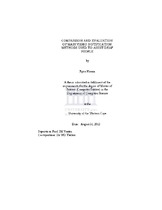| dc.contributor.advisor | Venter, I.M. | |
| dc.contributor.advisor | Tucker, William D. | |
| dc.contributor.author | Hoorn, Ryno | |
| dc.contributor.other | Dept. of Computer Science | |
| dc.date.accessioned | 2014-03-10T12:41:34Z | |
| dc.date.available | 2013/06/07 | |
| dc.date.available | 2013/06/07 10:33 | |
| dc.date.available | 2014-03-10T12:41:34Z | |
| dc.date.issued | 2012 | |
| dc.identifier.uri | http://hdl.handle.net/11394/2954 | |
| dc.description | Magister Scientiae - MSc | en_US |
| dc.description.abstract | In South Africa, Deaf people communicate with one another and the broader community by means of South African Sign Language. The majority of Deaf people who have access to a mobile phone (cell phone) use Short Message Service (SMS) to communicate and share information with hearing people, but seldom use it among themselves. It is assumed that video messaging will be more accessible to Deaf people, since their level of literacy may prevent them from making effective use of information that is disseminated via texting/SMS. The principal objective of the esearch was to explore a cost-effective and efficient mass multimedia messaging system. The intention was to adapt a successful text-based mass notification system, developed by a local nongovernmental organization (NGO), to accommodate efficient and affordable video mass messaging for Deaf people. The questions that underpin this research are: How should video- streaming mass-messaging methods be compared and evaluated to find the most suitable method to deliver an affordable and acceptable service to Deaf people? What transport vehicles should be considered: Multimedia Message Service (MMS), the web, electronic mail, or a cell phone resident push/pullapplication? Which is the most cost effective? And, finally: How does the video quality of the various transport vehicles differ in terms of the clarity of the sign language as perceived by the Deaf? The soft-systems methodology and a mixed-methods methodology were used to address the research questions. The soft-systems methodology was followed to manage the research process and the mixed-methods research methodology was followed to collect data. Data was collected by means of experiments and semi-structured interviews. A prototype for mobile phone usage was developed and evaluated with Deaf members the NGO Deaf Community of Cape Town. The technology and internet usage of the Deaf participants provided background information. The Statistical Package for Social Science (SPSS) was used to analyse the quantitative data, and content analysis was used to analyse the documents and interviews. All of the Deaf participants used their mobile phones for SMS and the majority (81.25%) used English to type messages; however, all indicated that they would have preferred to use South Africa sign language on their mobile phones if it were available. And they were quite willing to pay between 75c and 80c per message for using such a video-messaging service.Of the transport vehicles demonstrated, most Deaf people indic indicated that they preferred to use the SMS prototype (with a web link to the video) rather than the MMS prototype with the video attached. They were, however, very concerned about the cost of using the system, as well as the quality of the sign language videos. | en_US |
| dc.language.iso | en | en_US |
| dc.publisher | University of the Western Cape | en_US |
| dc.subject | Deaf Community of Cape Town | en_US |
| dc.subject | South African Sign Language, | en_US |
| dc.subject | Mobile phone | en_US |
| dc.subject | Mass video notification messaging | en_US |
| dc.subject | Short message service | en_US |
| dc.subject | Multimedia message service | en_US |
| dc.subject | video streaming | en_US |
| dc.subject | Cost effective | en_US |
| dc.subject | efficient delivery | en_US |
| dc.title | Comparison and evaluation of mass video notification methods used to assist Deaf people | en_US |
| dc.rights.holder | Copyright: University of the Western Cape | en_US |
| dc.description.country | South Africa | |

